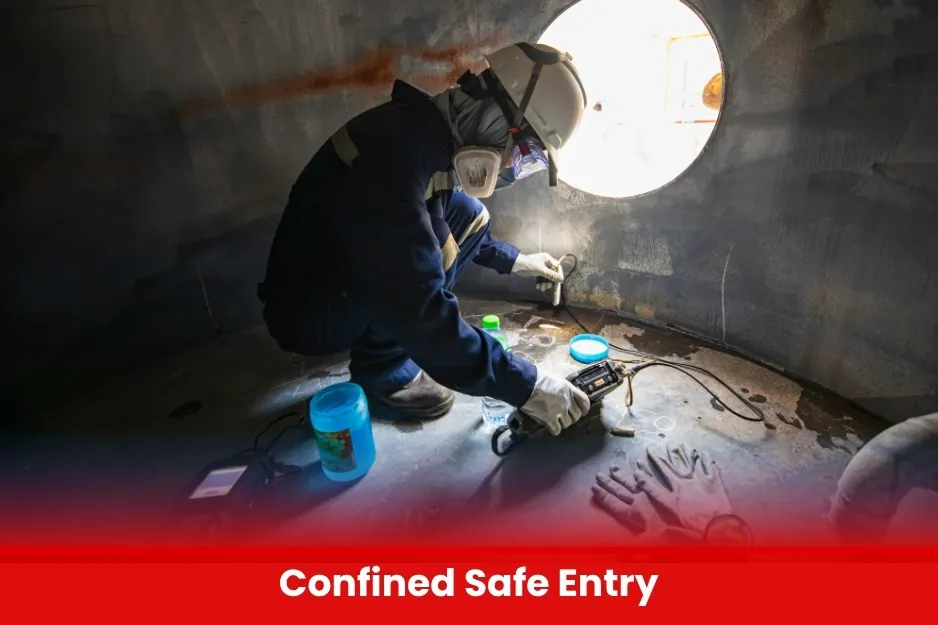Confined Safe Entry
Surveying software helps convert field data into accurate maps and models. BURRAQ UK uses advanced software tools alongside modern surveying equipment to improve precision and efficiency in surveying projects
At Buraaq UK, the safety of our employees and contractors is our top priority, especially when working in potentially hazardous environments such as confined spaces. Confined spaces are areas that are not designed for continuous occupancy and may have limited means of entry or exit, poor ventilation, or contain hazardous atmospheres.Entering confined spaces carries significant risks including oxygen deficiency, toxic gases, fire, explosion, and physical hazards. Therefore, strict procedures and controls are essential to ensure safe entry and work within these spaces.

Aim of Confined Safe Entry
To ensure that all confined space entries are conducted safely and in full compliance with UK legislation, by identifying and controlling hazards, providing adequate training and equipment, and establishing effective emergency response procedures to protect the health and safety of all personnel.
Course Overview
Confined Safe Entry
- Trained and Competent Personnel
- Individuals must have successfully completed Buraaq UK’s Confined Space Entry training (including hazard recognition, safe working practices, and emergency response).
- Refresher training is required as per company policy or after any incident.
- Physically Fit for Confined Space Work
- Personnel must be medically fit, free from conditions that could impair safe performance (e.g., claustrophobia, respiratory issues).
- Medical clearance may be required before assignment to confined space duties.
- Authorization and Permit Holders
- Only those authorized by Buraaq UK’s health and safety management system can issue or hold confined space entry permits.
- Workers must understand and comply with the permit-to-work system.
- Supervisors and Safety Watch (Attendants)
- Supervisors overseeing confined space work must be trained in hazard control, communication, and rescue procedures.
- Safety watch personnel must remain outside the confined space, maintaining communication and ready to initiate emergency response.
| Course Code | Curriculum Title | Credit | DLH |
|---|---|---|---|
| BUK1740-1 | Introduction to Confined Spaces | 2 | 10 |
| BUK1740-2 | Hazard Identification and Risk Assessment | 2 | 10 |
| BUK1740-3 | Permit-to-Work System | 2 | 10 |
| BUK1740-4 | Personal Protective Equipment (PPE) | 2 | 10 |
| BUK1740-5 | Atmospheric Testing and Monitoring | 2 | 10 |
| BUK1740-6 | Roles and Responsibilities | 2 | 10 |
1. Introduction to Confined Spaces
- Definition and examples of confined spaces
- Common hazards and risks (oxygen deficiency, toxic gases, engulfment, etc.)
- Legal framework: Confined Spaces Regulations 1997 & related UK laws
2. Hazard Identification and Risk Assessment
- How to identify hazards specific to confined spaces
- Conducting and documenting risk assessments
3. Permit-to-Work System
- Purpose and importance of the permit system
- Roles and responsibilities of permit issuers, entrants, and supervisors
- Steps for obtaining, validating, and closing permits
4. Atmospheric Testing and Monitoring
- Use and calibration of gas detectors and monitors
- Testing for oxygen levels, flammable gases, and toxic substances
- Continuous monitoring during entry
5. Personal Protective Equipment (PPE) and Safety Equipment
- Types of PPE used in confined spaces (respirators, harnesses, helmets)
- Correct selection, use, and maintenance
- Rescue equipment and communication devices
6. Safe Entry and Work Procedures
- Preparation and isolation of confined spaces
- Entry techniques and maintaining communication
- Emergency readiness and evacuation procedures
7. Roles and Responsibilities
- Duties of entrants, attendants (safety watch), supervisors, and rescue teams
- Communication protocols and reporting
8. Emergency Response and Rescue Procedures
- Recognizing signs of distress and emergencies
- Rescue planning and equipment use
- Coordination with emergency services
9. Case Studies and Practical Exercises
- Real-life incident reviews
- Hands-on training in equipment use and simulated confined space entry
- Confined Space Entrants
- Safety Watch / Attendants
- Supervisors and Team Leaders
- Rescue Team Members
- Health & Safety Officers / HSE Staff
- Contractors and Subcontractors
- All Modules within this qualification are assessed internally by the approved training Centre and externally verified by BURRAQ UK. The program uses a criterion-referenced assessment approach to ensure that learners successfully meet all required learning outcomes.
- A Pass in any unit is granted only when the learner submits valid, reliable, and authentic evidence that demonstrates achievement of the assessment criteria. The Assessor is responsible for reviewing this evidence and confirming that the learner has attained the expected standard.
